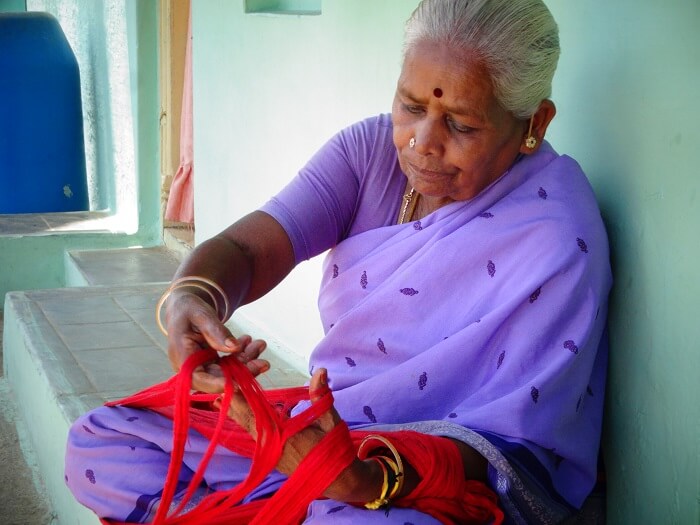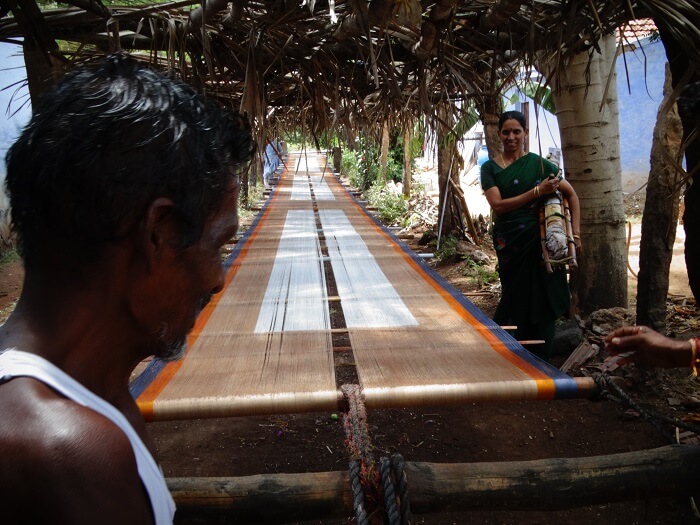COTTON SPIDER
1/2 , Kannaki Street,
Opp. Mariammal School,
Mahalingapuram,
Pollachi - 642 002.
Mail id : admin@cottonspider.com
Ph : +91 9489 221130
SAREE! The magical 6 yard piece of cloth which is a symbol of grace and pride for many Indian women, is the latest fashion craze for women from across the world. The one attire that many feared to die a slow death is back in its full glory again, and more and more people are opting to try new ways of draping it, to walk around in delight and contentment.
Have any one of us ever looked back and wondered how these beautiful intricate designs are woven into sarees, or how these designs come into life so beautifully? Given the fact that more than six and a half million people are engaged in weaving of clothes, it would be amazing to find out what exactly happens behind the scenes at a saree weaving unit, giving women the air and life they need in those beautiful yards of cloth.
We set out on a journey to Kullakkapalayam in Pollachi, Tamilnadu which has a rich tradition of weaving handloom sarees. They are famous for weaving handloom Negamam cotton sarees and silk sarees. The artistry there is passed through generations, and many of the weaving units are run by families. Some of the units are managed by families that come together and work as one by dividing the tasks among themselves.

We were greeted with the clickety-clack sounds of handloom machines echoing throughout the village, and an array of 100s of spools containing yarns made of cotton on our arrival at a weaving unit. We were further intrigued looking at those spools of yarn and the weaver there mentioned in detail about the innocent looking yet painstaking processes involved in weaving a handloom saree. The major steps include warping the thread, the winding up of thread, the starching, thread sizing and setting and finally weaving. We decided to walk through the steps through the eyes of a weaver.
The spools of yarns we saw earlier were loaded on to a wooden frame, the threads being fed through wooden rollers of the warping machinery and rolled, all of which enable loading the yarn in handloom machine. These threads are then wound up to make the threads stronger and smoother.

The warp which has been prepared is then treated with starch and oil to make it smooth and shinier. The starch is derived from either rice or millet. They brush the starch well onto the threads to avoid formation of lumps. The next way to weaving is fixing the thread count and setting the jacquard, and then finally weaving. All of these processes are labour intensive and time-consuming. They take around 15-16 days to complete the whole round of processes, but end up weaving around 42-45 yards of cloth, leaving unwoven warps in between which could be knotted for fringe while they are cut into sarees of desired lengths. We walked through all of the processes, which in turn means sarees in the making in various stages.

The working pattern of these artisans were breathtaking, and we were mesmerized by the way in which they wove beautiful, intricate designs of sarees. Simple colour-stained yarns of cotton just got transformed into magical wonders in a time-taking, complex, yet breathtaking process. Each piece of saree turned into a masterpiece in its own way.
We saw signs of deterioration in the health of a few of these artisans, with the constant handling of chemical dyes, and the wear and tear of constant strenuous exercise on their hands and feet, all in the name of holding up their tradition. They are fighters and don’t let go of their artistic traditions, no matter what it takes to sustain those. Each of them poured their heart and soul in doing their perfecting their roles in the weaving process. We cannot be proud of them more.
Many women get stuck when they consider buying sarees: the dilemma of choosing powerloom over handloom, hugely so because of the differences in price of both. One thing we can be sure of in a handloom saree is that it’s purely organic in a way, each saree being a work of art by the weaver, and the threads closely knit, making them more durable. Moreover, being one of India’s largest cottage industries, we are helping a group of artists sustain their tradition when we buy a piece of handloom saree.
Fret not gorgeous ladies, each one of you look so elegant in handloom sarees, that each time you wear one, you look absolutely stunning and divine! Not happy with the way you wear your saree? Be bold, don’t shy away from trying different ways of draping your favourites. Nothing can compliment you better than these 6 yards of magic!
Note of Thanks:
* Mr. Govindasamy, a gentleman we came across there, who helped us all throughout the journey in filling out the inside story. He has been in this field for more than 50 years in a traditional set-up. He weaves order-based for retailers, who give their requisite designs/patterns and the quantity they might require.
Author:
Resmi KrishnanKutty

No comments so far. Be first to leave comment below.